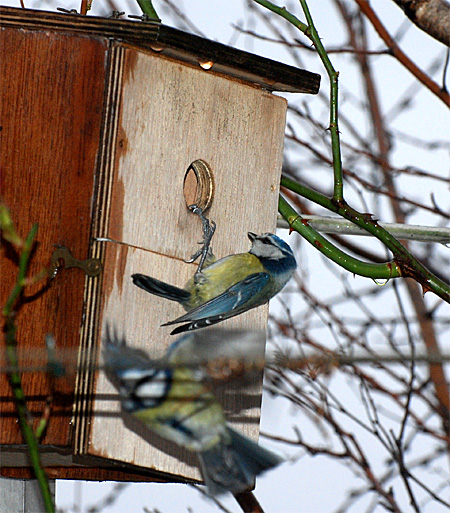Plume de Ville
From day to day.
°°°°°°°°°°°°°°°°°°°°°°° °
1er February
A
weather
not to put a tit outside. 8 °C this morning. Rain, wind, heavy
clouds.
None entered the nest box today. Short
passages for some sunflower seeds.

It is 15h, they come together, and both want to hang on the door of the nest box. Scramble, imbalance. One still hung ... by a finger. Then gives a quick glance at the entrance

No need to
convince you that it is raining, I think.

The interior of the nest
box seems also wet.
This is the first time in three years.
We must check the seals.
No
doubt,
these wings lowered, that's him.
In so doing he defends its territory, and also, tries to appear very
convincing
to his girlfriend to show him the birdhouse. (These pictures are from
yesterday).
What
do you
do when you are in the nest box? This is the female. She
may stay that way over half an hour, here
just 30s of this mad agitation.
Video January 29, 2008 12:30 180K 30s
 |
|
| Merci de patienter quelques secondes pendant le chargement... | |
| Ouvrir avec un autre programme. |
2 February
Sun, blue sky, et last! 3°C
Well installed
in the window box this morning, "our" couple of wood pigeons
[Columba
palumbus].
They
blithely trample plants and seem appreciate this bed of herbs
(rosemary, sage
and savoury).
They
remain quite shy and accept to be observed but at respectful distance.
The
photos are not very good through the windows and little light. We can
see
here the white patch at the neck of woodpigeon and his rose chest.

The tits
are very much present today. The weather is fine and visits are
frequent. In
the early afternoon she will spend half an hour in the nest box.

3 February
Sun and blue sky, 7°C
This
morning we find the wood pigeons again installed in the flowerpot. They
did not
sleep there, and settled there only in the early morning.
The program: sweet cooing, little tingling of feathers.
The magpies
[Pica pica] often walk with a high nose, on the terraces, attentive to
the
slightest movement. They feed primarily on insects. These goings-on are
funny
to watch. They explore all possibilities.
Here is one
hunting this time on a window.
Hey, want ...
It seems there was something. Let's see, let's see. No precipitation.
The easiest way is to go and see. The trick is to know the right time judge and act quickly. Win!

4 February
Rain
is
back.
Few
visits, six between 10h and 11h. Visits devoted to these beautiful
movements. This attitude is used to squish materials like moss in the
nest.
There is still nothing. Last year the first strands were brought on 9
February.
For now, we have neither detected the presence of the two chickadees in
the
nest box.


5 February
Grey,
rain,
wind, 10 °C this morning. Still greyness.
No
wood pigeons this morning. With this weather, we understand. It is noon
and
no tits either.
Need
to
wait until 14h to see them arrive and stay until 16h15. She remains in
the nest
box up 3/4ths of an hour.
With
its supplies!


Followed by
a short doze.


6 February
Luminous, 10°C
9h20
this
morning. The weather is fine; they arrive early.
It is he who goes into the nest box.

A second
later, she follows him. There is he, packed at the bottom of the photo;
he
tries to pass unnoticed.


A
look and
exits leaving her as mistress of the place.


These are the first pictures of both of them together in the nest box. In the afternoon, they will met inside again for a moment.
 There
have
been several entries in the nest box today. Usually it is she who
enters alone
one and stays a long time. He sings nearby.
There
have
been several entries in the nest box today. Usually it is she who
enters alone
one and stays a long time. He sings nearby. The opportunity to admire by the way, the distribution of white feathers on the blue dress.

We see less
often the great tit, usually just the male. I do not know where they
found a vacant
shelter.
7 February

Beautiful
sun all day.
Wood pigeons returned this morning.
Many passages throughout the day. They are there almost constantly and
he sings
and sings.
The first crocus of the year
8 February
Blue, blue, blue...
10 February
Cold in the
morning: 4 °C then 13 °C and blue sky.
A newcomer on the
balcony: a dunnock [Prunella modularis - Passeriformes prunnellidae -].
Also
called Hedge accentor or Hedge sparrow.
He
reminds
the sparrow, but has a grey head, grey-brown beside the eyes. He has
orange
legs and legs and beak are much finer than the sparrow. On the wing he
has a
narrow band of white feather tips visible here. Breast and belly are
clear.
This morning, in the sun, perched at the top of the poplar, it repeated
continuously
its melodious short sentence that allowed his identification. Although
small,
you her him, his singing is bright and sharp.
It is insectivorous (he has a fine beak). In winter when insects are
scarce,
they may eat seeds.























